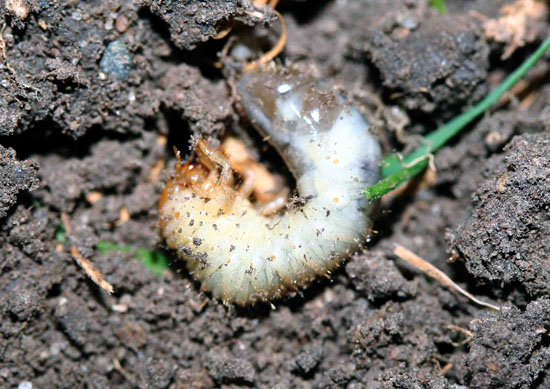Issue 12, July 25, 2011
White Grubs
The recent hot, dry weather and more of the same predicted has set us up for white grub damage to turfgrass this year. How severe will not be very predictable until early August when most of the grubs have hatched.
Basic to this question is where the eggs were laid and how many were laid. Masked chafer adult beetle emergence tends to be relatively constant in the state as the larvae are less dependent on soil moisture and dig deep enough in the winter to escape deeply frozen soils. Japanese beetle numbers vary more widely from year to year as they are impacted more by these factors. In areas where Japanese beetles are located, they tend to become the dominant white grub species anyway.
Japanese beetles are numerous in the eastern one to two counties of Illinois from Lake County in the northeastern corner south to Saline and Gallatin Counties where the Ohio River becomes the southern border of the state. They are also numerous in the Collinsville and Edwardsville areas of southwestern Illinois. Elsewhere, they are numerous in all Illinois cities and are spreading through the adjoining countryside.
Although Japanese beetles in east central Illinois are only about one-quarter of the maximum number that we have experienced in previous years, they appear to be present in heavy numbers in most of the rest of the state. In general, Japanese beetles emerged about a week early this year and closer to two weeks early in northern Illinois. This is good news for larval turf damage as most of the eggs were probably laid by early to mid-July.
White grub adults, including Japanese beetles, tunnel into the soil about one to two inches to lay their eggs. They prefer moist soil that is easy to dig into and are repelled by dry soil. There is also some evidence that they are attracted to lush, green grass over brown, dormant turf. Our heavy spring rainfall pattern continued through much of June, resulting in lush, green grass in non-irrigated areas into early to mid-July. Under these conditions, white grub adults lay their eggs in all turf areas. In normal rainfall years, non-irrigated turf is dry, brown, and dormant in July, so the beetles lay most of their eggs in irrigated turfgrass. This concentrates the white grub and resulting damage in these areas.

The early emergence of Japanese beetles this year when turf was lush and green makes it even more likely that the egg-laying was widespread. If that is the case, most turf areas will have white grubs, but they are likely to be below the damaging level of ten to twelve per square foot and treatment is unlikely to be needed. If the turf is heavily used, grub damage is likely to occur even at numbers slightly below this threshold because stressed turf will replace grub-eaten roots more slowly. If the turf is only lightly used, grub numbers may be as high as 15-18 grubs per square foot without developing brownish areas from grub feeding.
By the end of the first week of August, most of grubs will have hatched. Scout for grubs by cutting through the turf with a stout knife and prying it up. A few grubs are likely to be in the sod, but most will be exposed on the soil surface. White grubs are C-shaped, white scarab larvae with six legs, and brown heads. The ones that are the larval stages of Japanese beetle and masked chafers grow to about one inch in length, but in early August are usually about one-quarter inch long. Till the soil with the knife to reveal any grubs below the main root zone. In moist turf, the grubs will typically be within two inches below the sod; in dry soils, the grubs are likely to be four to six inches deep. Once the grubs are counted, replace the sod and tamp it down with your foot. Watering the area reduces the likelihood of brown patches where the sod was disturbed.
If high grub populations are present or expected, application of a long-lasting white grub insecticide is recommended. This includes chlorantroniliprole (Acelepryn), clothianidin (Arena), imidacloprid (Merit), or thiamethoxam (Meridian). In recent years, we have also recommended halofenozide (Mach 2) for this application. However, widespread failures of this product across the U.S. have been reported, possibly due to microbial degradation. In microbial degradation, microbes adapt to eat the pesticide. If you have had good results with Mach 2 in the past, feel free to continue using it but rotation with at least one other of the above insecticides on a yearly basis is recommended. If you have had treatment failures with Mach 2, microbial degradation may be the cause.
We generally recommend that these insecticides be applied during July as some can take two to three weeks to kill the grubs. Apparently, the grubs stop feeding soon after insecticide application so there is little threat of turf damage. The concern is that the client may check on the grubs and discover that they are still alive, resulting in unnecessary callbacks. For this reason, trichlorfon (Dylox) is usually recommended when grubs are present as it will kill the grubs within three days. However, it only lasts for five days so it should not be applied before grubs have hatched. Any grub insecticide application is more effective when watered in with at least one-half inch of water. (Phil Nixon)
Author:
Phil Nixon